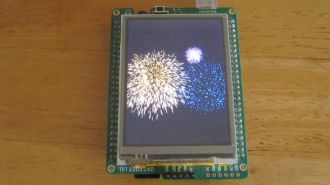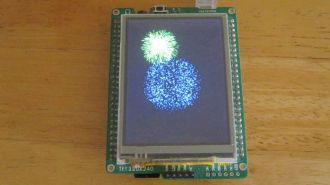
We strongly encourage users to use Package manager for sharing their code on Libstock website, because it boosts your efficiency and leaves the end user with no room for error. [more info]

Rating:
Author: Andrew Hazelden
Last Updated: 2013-06-25
Package Version: 1.0.0.0
Category: Gaming and Fun
Downloaded: 733 times
Not followed.
License: MIT license
The fireworks example creates an animated fireworks show on the Mikromedia PIC32 development board. The fireworks firmware demonstrates a way to use the VisualTFT resource collection feature to create movies. The code was written using VisualTFT and MikroC Pro for PIC32.
Do you want to subscribe in order to receive notifications regarding "Fireworks for Mikromedia PIC32" changes.
Do you want to unsubscribe in order to stop receiving notifications regarding "Fireworks for Mikromedia PIC32" changes.
Do you want to report abuse regarding "Fireworks for Mikromedia PIC32".
| DOWNLOAD LINK | RELATED COMPILER | CONTAINS |
|---|---|---|
| 1372193232_fireworks_for_mi_mikroc_pic32.rar [3.01MB] | mikroC PRO for PIC32 |
|
The Fireworks firmware lets you watch a fireworks show on your Mikromedia PIC32 Board.
Watch on YouTube
The fireworks firmware lets you celebrate any occasion with style.
View full image
Mikromedia Image Sequence Tips:
When creating an image sequence for use with VisualTFT use the file naming convention of image###.bmp
eg. image000.bmp to image60.bmp
The images should be loaded in Visual TFT using the resource collection icon in the toolbar. Save the images to an external VisualTFT resource file.
The fireworks_image_sequence.h header file creates the pointer array named "animated_fire" that holds the names of each of the frames in the image sequence.
I looked in the file fireworks_resources.h to find out the names that VisualTFT / MikroC used for each BMP frame in the animation.
When VisualTFT saves an external image resource to the .res file it writes the images pointer address for the image fireworks00.bmp in the resource.h file as:
#define fireworks00_bmp 0x0000070F
If you are creating a pointer array for the images keep in mind that C code arrays start at index position 0. This also means you have to be careful of off by one errors when looping the animation.
eg. The first frame in the array begins at animated_fire[0] and image number 60 is located at animated_fire[59].
There are two ways you can create an animation using MikroC and the TFT Library. You could either use the external TFT image drawing function:
TFT_EXT_Image(0, 0, animated_fire[current_frame], 1);
or your could use the VisualTFT centric workflow of swapping the current image in the picture name attribute. In the events_code.c file you could have a button press that causes an image to be animated.
eg. If you have a VisualTFT image on the current screen named "fireworks" you could swap the picture using:
void fireworksOnPress() {
current_frame++;
fireworks.Picture_Name = animated_fire[current_frame];
DrawImage(&fireworks);
}